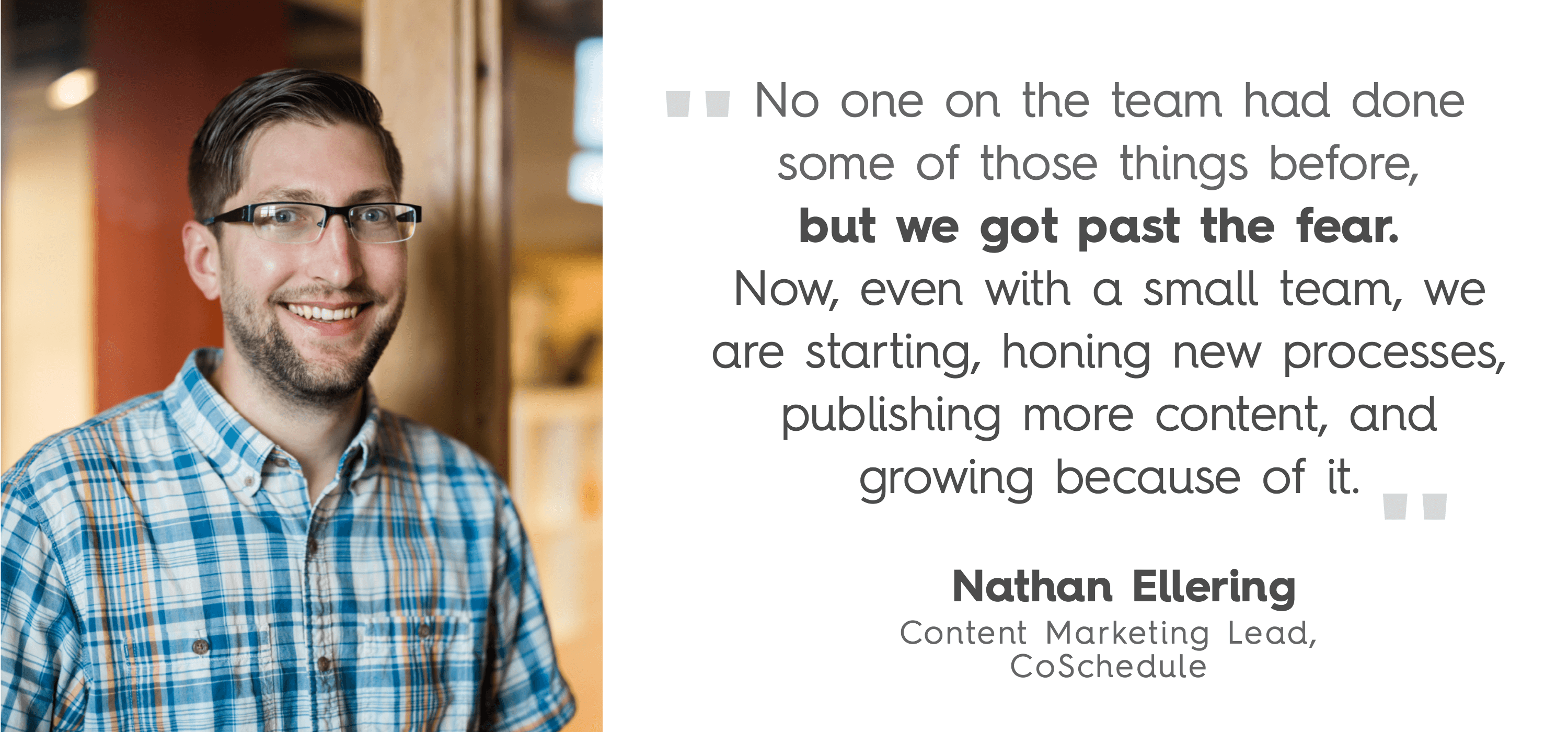If you’re a brand publisher, you should know about CoSchedule. In addition to its incredibly convenient marketing calendar tool (which we proudly use), the brand has quickly become the go-to experts for all things content marketing. As a brand whose livelihood depends on brand publishing, the Coschedule content strategy is knocking it out of the park.
Each week, they publish several well-written, data-heavy articles on all angles of content marketing, from how to increase social traffic to practical headline tips, that help marketers do their jobs better. And all that fantastic content has shown mega results. (In only 2 years, they’ve increased traffic sixfold.)

Diving into the Coschedule Content Strategy
To find out how they do it, we talked to Content Marketing Lead Nathan Ellering, who shared their step-by-step process for coming up with genius ideas and turning them into content-rich, SEO-slaying traffic boosters. Warning: This interview might just change the way you approach your entire content strategy. Grab a pen.

C5: Between your newsletters and blog, you have a consistent publishing cadence. What does your editorial process look like to maintain that momentum?
NE: Prioritizing consistency ensures that we publish quality content frequently. And when that happens, we grow.
We’ve actually just shaken up the game with our process recently, employing the keep-it-simple-stupid philosophy to remove unnecessary steps from our publishing process to help us finalize content quicker. The process moves in four easy phases:
- Plan: There’s a saying we live by at CoSchedule that goes, “Plan your work, then work your plan.” We find a topic, angle, and keyword for every piece of content we publish before we start executing. Then we throw it on our editorial calendar and plan tasks backward to make sure all tasks for the content are complete by the deadline. Right now, we have content 100% complete with writing, design, and SEO for four weeks out as we work on new content for five to six weeks from now.
- Write: We write content that is so good the first time around that if we didn’t need to include graphics in our content, we’d feel 100% confident in publishing immediately. That means that everything is error-free and correctly formatted. This takes three days or less, which is pretty good considering our blog posts average 4,000 words long.
- Design: After the written content is amazing, we design inline graphics and content upgrades, which are complementary templates we gate to help us build our email list while providing something extremely valuable to our audience to help put the advice we give in our content into practice. Design typically takes less than one day.
- SEO and final check: When everything looks like it’s ready to publish, we polish our meta tags, slugs, headlines and subheadlines, and body copy. This is more of a spot check to make sure Ts are crossed and Is are dotted while ensuring that we accurately target the keyword we’re targeting with our content. This phase takes about 30 minutes.
That process helps us publish two to three blog posts every week (Monday, Wednesday, and Thursday), while also giving us the opportunity to share that content with our email subscribers consistently (Monday, Tuesday, and Thursday).
C5: I’m always impressed by the variety of posts you produce. You’d think the subject of publishing might eventually go stale, but you always have fresh ideas. How does your team come up with content ideas?
NE: Like all good solutions, we built a framework to come up with really good ideas because of a problem: Our editorial calendar was empty one day, and we held an all-hands marketing team meeting to fill it up.
I remember walking into the meeting not exactly knowing how we’d find ideas, just knowing that we would. What came out of that touch point was a three-phrase brainstorming session we still use to develop blog post ideas and more:
- Solo brainstorming: Yep, this is an all-hands meeting with no one talking at the beginning, just jotting down every idea on a Post-it note. It helps to tell your team to come prepared (for those people who need to think just a little more than others). Anyway, get everyone in the room, and get every idea out of their head—no need to reflect on idea quality yet.
- Ranking: Now your team rates each idea on a scale of 1 to 3, with 3 ideas being the best, 2 ideas being OK, and 1 ideas being stinkers. The best way to do this is by having one person read each idea out loud while getting the votes from your team via a chat messenger tool like HipChat or Slack. This way, no one skews the votes of others due to the Asch social conformity psychological principle that you’re more likely to agree with others who’ve voiced opinions before you.
- Winner optimization: This is when the lead finally shares with the team all of the 3-rated ideas. The team works together to find a perfect angle for every 3-rated idea that the audience will love. If there aren’t enough 3-star ideas, now is the time to explore how you could turn a 2-rated idea into something amazing by exploring unique angles, too.
We try to only cover topics centered around planning, executing, and organizing marketing, so this process helps us come up with diverse ideas that solve complex, specific problems.
C5: What type of content have you found the most success with, and is there anything you had high hopes for that fell flat?
NE: We’ve had quite a variety of super successful content, and mixed in there are failures that followed the same guiding principles.
The most successful content we’ve published has exemplified five unique characteristics that now guide all of our content production. We call this framework our Standard Of Performance, a term from Bill Walsch’s book, The Score Will Take Care Of Itself, with each standard as a pillar of success:
- Topic: The topic needs to be well-chosen to help our intended audience. We accomplish this through the brainstorming exercise I just mentioned in the previous question.
- Keyword: It makes sense to help our audience find our content when they need it most, even if it’s long after we’ve published it. Search engine optimization helps us make the most of our investment into content creation while also connecting what we want to say to the words our audience uses to describe their challenges.
- Research: Data, examples, and experience drive great content. This helps us make sure the angle we target is backed up while proving that the advice we provide will end in big results after practical application.
- Comprehensiveness: While we may cover topics that our competition has covered before us, it is our goal to provide the absolute best piece of content on the entire internet for any topic we cover. That includes advice coupled with actionable, step-by-step guidance and deep attention to detail and execution.
- Email: Our inbound content exists to attract potential customers to use CoSchedule as a marketing calendar. So we optimize everything to convert traffic into email subscribers who will continue to get awesome, actionable content from us while also giving us the opportunity to share more information about the tool we offer that helps organize the chaos of content marketing.
Here are a few examples:
- What 16 Studies Say About The Best Times To Post On Social Media
- The Ultimate Guide To Using Color Psychology In Marketing + Free Color Schemes
- How To Create A Social Media Strategy (With 3 Steps And A Template)
- How To Write Headlines That Drive Traffic, Shares, And Search Results
- How To Use Hashtags Effectively Without Being Annoying
C5: How does visual content factor into your content strategy?
NE: Visual content is one of the primary ways we stand apart from our competition. We have a dedicated graphic designer, Ashton Hauff, who works through all of our content marketing graphics to tell complex stories in visuals for those who aren’t big readers.
We’ve found infographics and info-images often tell a story better than words themselves. Plus, solid design gives us the halo effect, which creates a solid first impression for our brand and, therefore, our product.
C5: What stumbling blocks has CoSchedule overcome in terms of your own content marketing?
NE: Starting. It’s easy to fear starting something new for bajillions of reasons:
- You’ve never done it before.
- You could fail.
- You could fail miserably.
- If it works, you have to maintain it.
- If you’re too successful, you think everything else you do should be as successful.
And the list goes on.
As a team, we’ve focused on blogging for a very long time and honing our internal process. Recently, we’ve started doing more—courses, e-books, podcasts, videos—and a ton more is on our radar.
No one on the team had done some of those things before, but we got past the fear. Now, even with a small team, we are starting, honing new processes, publishing more content, and growing because of it.
C5: You have a direct line to the thousands of marketers and bloggers who use CoSchedule. What’s the biggest publishing mistake you see marketers making over and over?
NE: Quitting. Content marketing—and most marketing in general—isn’t a quick win.
In your first six months, you may not notice huge pageviews or conversions. But. When you focus on publishing quality content consistently, the content you originally publish will serve as a foundation of trust.
Your audience will notice newer content, then look at the other stuff you’ve published. If they like (nearly) all of it—and not just some of it—you will earn their trust and they will become a subscriber.
Marketing is a long-tail strategy.
I know this from experience at CoSchedule. When I started in November 2014, we had an email list of about 14,000, page views of 175,000, and a customer base of 2,000. Through content marketing, we’ve built our audience to 105,000+, nearly 1 million monthly page views, and 7,000 customers.
We built our authority because we published content and built an amazing organizational tool as if we already had a huge audience.
C5: Can you give us a few tips or tricks that help you work smarter, not harder when it comes to publishing?
NE: First, focus on 10x growth projects and forget the 10%. What I mean by that is this: Prioritize projects that have potential for huge growth rather than ones you simply do because you’ve always done them but don’t actually impact your goals. You know what those are.
Then comes this honest advice: Keep it simple. Cut out needless processes and people who aren’t adding value to your workflow. The fewer the steps in your workflow, the easier it will be to complete quickly.
C5: In addition to CoSchedule, what app/tool could you not live without?
NE: We use a variety of tools to help us out at CoSchedule, all of which help us improve productivity because we’re using tools designed for the job instead of settling for what we already have:
…that’s what I’ve got off the top of my head.
What trends do you predict for the future of publishing?
I still stand by what I mentioned here.
Many thanks to Nathan for sharing his thoughts with us. For more wisdom from game-changers in content marketing and content strategy, check out these Q&As:
- PopSugar’s snap queens share their expert tips on how to run the best brand Snapchat.
- Business Insider’s Mike Nudelman tells us what publishers want from your content.
- LinkedIn’s Alex Rynne explains how to use LinkedIn to build your personal and professional brand.





